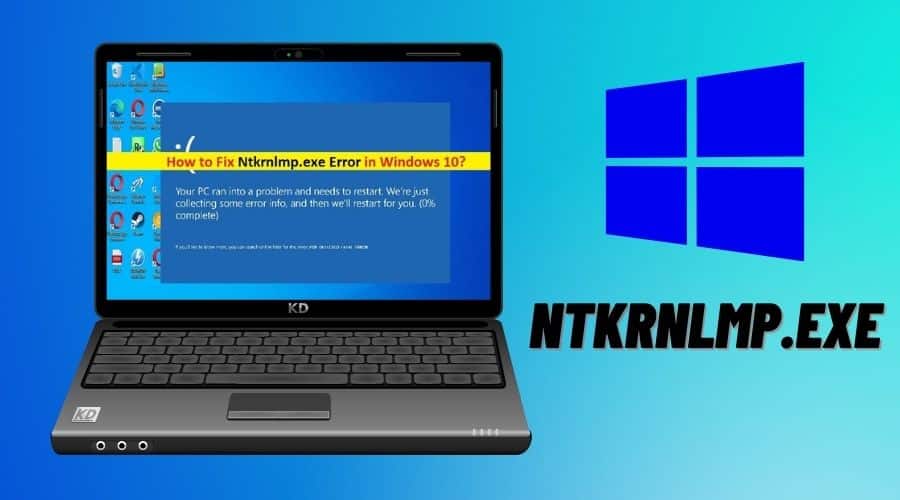Every Windows user has experienced the bluescreen of death at one point while using their PC. It is a terrifying experience the first time it happens, but it gets easier to deal with it. Understanding the root cause of the blue screen of death makes it easier to deal with it when it happens. The Ntkrnlmp.exe is one of the programs responsible for causing the blue screen of death. What is Ntkrnlmp.exe? Is it a Virus or Malware?
Have you ever experienced the blue screens of death while using your PC? It is normal to get the blue screen of death if you are a frequent Windows user. You can learn the root cause of the blue screen of death to put yourself in a better position to fix it when it happens. The Ntkrnlmp.exe utility program is one of the system programs that can cause the bluescreen of death. What is Ntkrnlmp.exe? Is it a Virus or Malware?
What is Ntkrnlmp.exe?

The Ntkrnlmp.exe is a utility program from Microsoft Inc. tasked with checking all the essential hardware and software necessary for running your PC are available. The Ntkrnlmp.exe is an abbreviation for the utility program and means Kernel Multi-Processor in full. The Ntkrnlmp.exe is part of the Kernel program tasked with corralling processes and programs responsible for running your Windows OS.
Is Ntkrnlmp.exe a Virus or Malware?
The Ntkrnlmp.exe is a legit utility program from Microsoft Inc., and deleting it from your OS might lead to a system crash. However, the utility program can cause problems resembling a virus/malware attack.
You can follow the troubleshooting tips below to fix errors with the Ntkrnlmp.exe utility program.
1. Checking the RAM and power cords/adapters

You can start by checking your RAM sticks and power cords/adapters for damages. Damaged power cords/adapters and RAM cause you to experience the Ntkrnlmp.exe error on your PC. Change the damaged RAM and power cords/adapters before checking if the Ntkrnlmp.exe error message is still there.

2. Running the System File Checker Command
You can follow the steps below to run the System File Checker Command using the CMD terminal.
Step 1: Click on the Search icon at the bottom left of your screen before searching for the CMD app.

Step 2: Right-click on the CMD app and select the Run as administrator option to launch a CMD console with administrator privileges.
Step 3: Type the [dism /online /cleanup-image /restorehealth] Command in the terminal before pressing the Enter key.
Step 4: Type the [sfc /scannow] Command on your CMD app before pressing the Enter key.

Step 5: Wait for your PC to scan and repair system errors before restarting your computer.
3. Update your graphics drivers
You can follow the steps below to update your graphics card drivers.
Step 1: Right-click on the Start icon before clicking on the Device Manager option.
Step 2: Locate the Display Adapters folder before clicking on it to expand it.

Step 3: Pick your preferred display before right-clicking on it. Click on the Update driver option to update the drivers for your graphics card. Ensure you follow the on-screen instructions to complete updating your graphics card drivers.

4. Fixing bad sectors on your hard drive

Fixing bad sectors on your hard drive can help you resolve Ntkrnlmp.exe errors. You can right-click on your preferred drive partition before clicking on the Properties option. Select the Tools tab before scanning and fixing bad sectors on your hard drive.
5. Uninstalling incompatible programs

You can uninstall incompatible third-party programs to fix Ntkrnlmp.exe errors on your PC. The most recent third-party program installation is usually the culprit. Launch the Control Panel before clicking on the Programs and Features option to uninstall third-party applications on your PC.
6. Disabling the C-State and EIST on your BIOS
You can follow the steps below to disable the C-State and EIST on your BIOS.
Step 1: Press the Esc key when starting your PC to enter into BIOS mode.
Step 2: Locate the Advanced section before clicking on it. Click on the CPU Configuration option before clicking on the CPU Power Management Configuration option.


Step 3: Disable the Intel C-STATE tech and Intel EIST features before saving and exiting the BIOS mode.

7. Disabling the CPU overclocking feature

The CPU overclocking feature can cause you to experience the Ntkrnlmp.exe error on your computer. Gamers usually prefer to use the CPU overclocking feature, but it can interfere with your power management plan, thus causing you to experience the Ntkrnlmp.exe error.
8. Perform a clean boot

Performing a clean boot on your computer can help resolve issues with incompatible programs on your computer. You can open the Windows System Configuration tool to prevent incompatible programs from launching.

Conclusion
Now you know what the Ntkrnlmp.exe system file is. However, it’s also important to note that some viruses and malware may masquerade as genuine system process files. As such, you might want to do a complete system scan whenever you see any malicious file on your PC. That being said, we wrap up this post. I hope you found it very useful.
